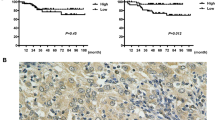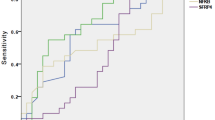Summary
The utility of placental growth factor (PlGF) and its receptor VEGFR-1 (Flt-1) as biomarkers for cervical cancer has not been clarified yet. To address this issue, we investigated the levels of soluble PlGF (sPlGF) and soluble Flt-1 (sFlt-1) in the serum from patients with early cervical cancer, cervical intraepithelial neoplasia (CIN) and controls in this study. sPlGF and sFlt-1 were detected in 44 preoperative patients with cervical cancer, 18 cases with CIN, and 20 controls by ELISA. It was found that both sPlGF and sFlt-1 were significantly increased in the cervical cancer group as compared with those in CIN and control groups. sPlGF presented a high diagnostic ability of cervical cancer, with a sensitivity of 61.36% and a specificity of 89.47%; and sFlt-1 with a sensitivity of 50.00% and a specificity of 92.11%. Importantly, the combined use of sPlGF and sFlt-1 could increase the diagnostic rate of cervical cancer, with a sensitivity of 70.45% and a specificity of 92.11%. These results indicated that both sPlGF and sFlt-1 in circulation can serve as possible valuable diagnostic biomarkers for cervical cancer, and the combined use of them can be more valuable to diagnose the patients with early cervical cancer.
Similar content being viewed by others
References
Ferlay J, Soerjomataram I, Dikshit R, et al. Cancer incidence and mortality worldwide: Sources, methods and major patterns in GLOBOCAN 2012. Int J Cancer, 2015,136(5):E359–386
Stafl A, Mattingly RF. Angiogenesis of cervical neopl asia. Am J Obstet Gynecol, 1975,121(6):845–852
Bremer GL, Tiebosch AT, van der Putten HW, et al. Tumor angiogenesis: an independent prognostic parameter in cervical cancer. Am J Obstet Gynecol, 1996,174(1 Pt 1):126–131
Cao Y, Chen H, Zhou L, et al. Heterodimers of placenta growth factor/vascular endothelial growth factor. Endothelial activity, tumor cell expression, and high affinity binding to Flk-1/KDR. J Biol Chem, 1996,271(6):3154–3162
Maglione D, Guerriero V, Viglietto G, et al. Isolation of a human placenta cDNA coding for a protein relation to the vascular permeability factor. Proc Natl Aacd Sci USA, 1991,88(20):9267–9271
Migdal M, Huppertz B, Tessler S, et al. Neuropilin-1 is a placenta growth factor-2 receptor. J Biol Chem, 1998,273(35):22 272–22 278
Park JE, Chen HH, Winer J, et al. Placenta growth factor. Potentiation of vascular endothelial growth factor bioactivity, in vitro and in vivo, and high affinity binding to Flt-1 but not to Flk-1/KDR. J Biol Chem, 1994,269(41):25 646–25 654
Odorisio T, Schietroma C, Zaccaria ML, et al. Mice overexpressing placenta growth factor exhibit increased vascularization and vessel permeability. J Cell Sci, 2002,115(Pt 12):2559–2567
Bagley RG, Ren Y, Weber W, et al. Placental growth factor upregulation is a host response to antiangiogenic therapy. Clin Cancer Res, 2011,17(5):976–988
Owen LA, Uehara H, Cahoon J, et al. Morpholinomediated increase in soluble Flt-1 expression results in decreased ocular and tumor neovascularization. PLoS One, 2012,7(3):e33576
Zhu H, Li Z, Mao S, et al. Antitumor effect of sFlt-1 gene therapy system mediated by Bifidobacterium Infantis on Lewis lung cancer in mice. Cancer Gene Ther, 2011,18(12):884–896
Yang S, Cheng H, Cai J, et al. PlGF expression in pre-invasive and invasive lesions of uterine cervix is associated with angiogenesis and lymphangiogenesis. APMIS, 2009,117(11):831–838
Yang S, Cheng H, Huang Z, et al.. Circulating Soluble Neuropilin-1 in Patients with Early Cervical Cancer and Cervical Intraepithelial Neoplasia Can Be Used as a Valuable Diagnostic Biomarker. Dis Markers, 2015,2015:506428
Kim KJ, Cho CS, Kim WU. Role of placenta growth factor in cancer and inflammation. Exp Mol Med, 2012,44(1):10–19
Gadducci A, Tana R, Cosio S, et al. The serum assay of tumour markers in the prognostic evaluation, treatment monitoring and follow-up of patients with cervical cancer: a review of the literature. Crit Rev Oncol Hematol, 2008,66(1):10–20
Gu Y, Wan C, Qiu J, et al. Circulating HPV cDNA in the blood as a reliable biomarker for cervical cancer: A meta-analysis. PLoS One, 2020,15(2):e0224001
Ma G, Song G, Zou X, et al. Circulating plasma microRNA signature for the diagnosis of cervical cancer. Cancer Biomark, 2019,26(4):491–500
Zheng M, Hou L, Ma Y, et al. Exosomal let-7d-3p and miR-30d-5p as diagnostic biomarkers for non-invasive screening of cervical cancer and its precursors. Mol Cancer, 2019,18(1):76
Yin S, Yang M, Li X, et al. Peripheral blood circulating microRNA-4636/-143 for the prognosis of cervical cancer. J Cell Biochem, 2020,121(1):596–608
Shantha Kumara HM, Cabot JC, Yan X, et al. Minimally invasive colon resection is associated with a persistent increase in plasma PlGF levels following cancer resection. Surg Endosc, 2011,25(7):2153–2158
Cheng SJ, Lee JJ, Cheng SL, et al. Increased serum placenta growth factor level is significantly associated with progression, recurrence and poor prognosis of oral squamous cell carcinoma. Oral Oncol, 2012,48(5):424–428
Huang W, Zhu S, Liu Q, et al. Placenta growth factor promotes migration through regulating epithelial-mesenchymal transition-related protein expression in cervical cancer. Int J Clin Exp Pathol, 2014,7(12):8506–8519
Ruffini F, Failla CM, Orecchia A, et al. Expression of the soluble vascular endothelial growth factor receptor-1 in cutaneous melanoma: Role in tumour progression. Br J Dermatol, 2011,164(5):1061–1670
Nagaoka S, Yoshida T, Akiyoshi J, et al. The ratio of serum placenta growth factor to soluble vascular endothelial growth factor receptor-1 predicts the prognosis of hepatocellular carcinoma. Oncol Rep, 2010,23(6):1647–1654
Duda DG, Willett CG, Ancukiewicz M, et al. Plasma soluble VEGFR-1 is a potential dual biomarker of response and toxicity for bevacizumab with chemoradiation in locally advanced rectal cancer. Oncologist, 2010,15(6):577–583
Fan F, Samuel S, Gaur P, et al. Chronic exposure of colorectal cancer cells to bevacizumab promotes compensatory pathways that mediate tumour cell migration. Br J Cancer, 2011,104(8):1270–1277
Kuemmel S, Thomas A, Landt S, et al. Circulating vascular endothelial growth factors and their soluble receptors in pre-invasive, invasive and recurrent cervical cancer. Anticancer Res, 2009,29(2):641–645
Wu FT, Stefanini MO, Mac Gabhann F, et al. A systems biology perspective on sVEGFR1: its biological function, pathogenic role and therapeutic use. J Cell Mol Med, 2010,14(3):528–552
Bertin S, Mohsen-Kanson T, Baqué P, et al. Tumor microenvironment modifications induced by soluble VEGF receptor expression in a rat liver metastasis model. Cancer Lett, 2010,298(2):264–272
Takei Y, Mizukami H, Saga Y, et al. Suppression of ovarian cancer by muscle-mediated expression of soluble VEGFR-1/Flt-1 using adeno-associated virus serotype 1-derived vector. Int J Cancer, 2007,120(2):278–284
Author information
Authors and Affiliations
Corresponding author
Additional information
This work was supported by the National Natural Science Foundation of China (No. 81202063).
Conflict of Interest Statement
The authors have no conflict of interest.
Rights and permissions
About this article
Cite this article
Yang, Sh., Wang, Xl., Cai, J. et al. Diagnostic Value of Circulating PIGF in Combination with Flt-1 in Early Cervical Cancer. CURR MED SCI 40, 973–978 (2020). https://doi.org/10.1007/s11596-020-2269-y
Received:
Accepted:
Published:
Issue Date:
DOI: https://doi.org/10.1007/s11596-020-2269-y




